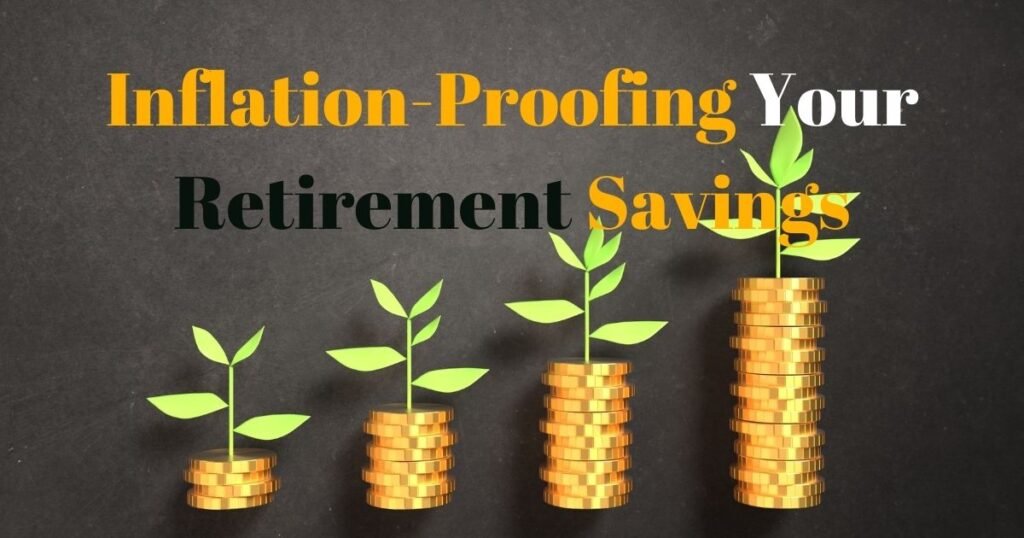Saving for retirement is a wise financial move, but with inflation on the rise, However, with inflation on the rise in recent years, there is concern about inflation-proofing your retirement savings for 2025, inflation is expected to remain elevated compared to historical levels.
This creates a need for savers to take proactive steps to inflation-proof their nest eggs. This article provides a comprehensive guide to strategies for inflation-proofing your retirement savings for 2025 and beyond. It explains key moves like maximizing tax-advantaged retirement contributions, investing more aggressively early in your career, and owning assets that rise with inflation
Assessing Your Current Retirement Savings
Before implementing inflation-proofing strategies, take stock of your current retirement accounts. Here are some questions to ask:
- What types of retirement accounts do you have (401k, IRA, etc.)?
- How much is currently saved in each account?
- What is the asset allocation (mix of stocks, bonds, cash) in each account?
- What are the current investment returns?
- Are you taking full advantage of any available employer match?
This information provides a snapshot of where you stand today and helps identify opportunities to strengthen your savings against inflation.
Maximizing 401k and IRA Contributions
Contributing up to the maximum amount allowed to tax-advantaged retirement accounts like 401ks and IRAs should be priority one. For 2024, the limits are:
- 401k contribution limit: $21,500
- IRA contribution limit: $6,500
- Age 50+ catch-up contribution: $7,500
If you aren’t already maxing out contributions, strive to increase by 1-2% each year. This pre-tax or tax-deferred savings will grow faster than post-tax dollars.
Any employer match is free money you should be capturing too! If you get a 50% match up to 6%, contribute at least 6% to maximize that match.
Harnessing the Power of Compound Growth
Inflation erodes retirement savings slowly over time. One way to counter its effects is compound growth. Your investments earn returns which then also earn returns. With compound growth, your money snowballs over time.
Say at age 25, you invest $5,000 and earn a 7% annual return. By age 65 that $5,000 would grow to over $90,000!
The earlier you start saving, the more powerful compound growth becomes. Use the power of compounding to counter inflation by starting to save as soon as possible.
Investing More Aggressively While Younger
As you age, your portfolio should gradually shift to more conservative investments with less risk. But when first starting out, investing more aggressively while younger can provide inflation-beating returns.
How can millennials and Gen Z invest more aggressively? Options include:
- Individual stocks: Buying individual stocks or investing in a basket through an app can provide higher returns. Be sure to research thoroughly and diversify.
- Growth ETFs: Exchange-traded funds focused on high-growth sectors like technology or healthcare offer growth potential.
- Small-cap funds: Funds investing in up-and-coming small companies may achieve larger returns. They come with more volatility, but time is on your side.
- International equities: Economic growth is surging overseas in some regions like Asia and Latin America. International equities provide nice diversification too.
Don’t abandon bonds and dividend stocks entirely, but tilting towards a higher equity allocation can help counter inflation.
Seeking Income-Generating Assets
Bonds and bond funds are traditionally core retirement portfolio holdings. But bonds alone struggle to keep pace with rising costs.
Instead, look to supplement your fixed income allocation with assets capable of generating higher income via dividends. Some options include:
- Dividend stocks: Leading dividend payers come from sectors like financials, industrials, and utilities. Do your homework to find companies with stable payouts.
- Dividend ETFs: Gain diversified dividend exposure through ETFs specializing in domestic or international dividend stocks.
- REITs: Real estate investment trusts pay out income derived from their property holdings. Publicly traded REITs offer liquidity too.
- Preferred stock: Preferred shares offer higher fixed dividend payments than common shares, providing bond-like income.
- Infrastructure funds: Assets like pipelines, data centers, and telecom towers generate income and provide inflation protection.
Shielding Against Inflation with TIPS
Treasury Inflation-Protected Securities (TIPS) are bonds issued by the U.S. government that provide protection against inflation. The principal value adjusts up or down with inflation as measured by CPI.
The interest rate paid on TIPS is fixed, but the amount of interest changes based on the adjustable principal value. So rising inflation means more interest income.
TIPS can preserve purchasing power and provide a hedge against rising prices. Holding 5-20% of your portfolio in TIPS is reasonable depending on your inflation outlook.
Owning Tangible Assets
Tangible assets that hold real value also act as an inflation hedge. The two most common inflatable hedges are real estate and gold.
- Real estate: Income-generating rental property delivers rental income that rises with inflation. Primary residence values also typically keep pace with inflation long term.
- Gold: This precious metal has historically held its value during inflationary periods. You can own gold directly, via ETFs, or through stocks of gold miners.
Other tangible assets providing inflation protection include farmland, commodities, and fine art.
Choosing Prudent Portfolio Withdrawal Rates
To sustain your nest egg over decades of retirement, prudent portfolio withdrawal rates are a must. Financial advisors caution against initial withdrawal rates over 4-5%.
So on a $1 million portfolio, your first year spending would be capped at $40,000-50,000.
From there, adjust withdrawals annually for inflation to maintain purchasing power. If portfolio returns exceed inflation, you may be able to increase your withdrawals. But it’s critical to be cautious, especially early in retirement.
Adopting conservative withdrawal rates helps ensure your savings stay inflation-proofed throughout retirement.
Reviewing Asset Allocation Regularly
Over decades of retirement, it’s essential to review your asset allocation regularly, at least annually. While younger, having significant exposure to stocks provides growth potential to outpace inflation.
But as you age, dialing down the risk to preserve capital becomes increasingly important. You don’t want to take big losses near retirement that destroy savings.
A common rule of thumb is to subtract your age from 110, with the resulting percentage representing your stock allocation. So at age 60, target 50% stocks. At age 70, target 40% stocks. Adjust these percentages based on your risk tolerance and evolving needs.
Maintaining Healthy Returns Without Excess Risk
A balanced, diversified portfolio holds the key to maintaining healthy returns without excess risk. Here are tips for building a well-rounded, inflation-fighting portfolio:
- Hold globally diversified stocks across market caps, sectors, and geographies
- Balance higher returning assets like stocks with lower risk ones like bonds and cash
- Incorporate inflation-fighting assets like TIPS, dividend payers, and real estate
- Reinvest dividends and interest to benefit from compound growth
- Employ smart rebalancing and dollar-cost-averaging strategies
- Limit portfolio withdrawals, especially early in retirement
Finding the right mix that aligns with your risk appetite and timeline is key. Work with a financial advisor to craft your inflation-proofing plan.
Leveraging Time Horizon with Annuities and Delayed Benefits
If you have the flexibility to delay tapping retirement savings and benefits, the time horizon can provide significant inflation protection.
For example:
- Delaying Social Security benefits results in higher monthly payments down the road. For each year you delay past your full retirement age up until age 70, benefits increase by about 8%.
- Buying an inflation-adjusted annuity that begins future guaranteed payments in 10 or 20 years provides a predictable future income stream.
- Drawing from Roth accounts before traditional ones allows more years for tax-deferred growth.
Maximizing these time-based strategies can squeeze more inflation protection from your nest egg.
Managing Healthcare Costs in Retirement
While not directly an investment strategy, containing healthcare spending has become an essential part of inflation-proofing retirement. Healthcare inflation consistently outpaces general inflation.
Some tips to curb healthcare costs without sacrificing coverage include:
- Choose Medicare Advantage plans that offer capped out-of-pocket costs
- Take advantage of employer-provided retiree health benefits if available
- Explore Medicare supplements to limit costs not covered by Medicare
- Sign-up for prescription drug assistance programs offered by drug companies
- Take advantage of preventative care and health screenings to stay healthy
As big-ticket healthcare costs continue climbing, managing these costs is key to making retirement savings last.
Considering Delaying Retirement a Few Extra Years
While not an ideal option, delaying retirement provides dual inflation-fighting benefits:
- A few extra years of earned income and retirement plan contributions
- A few fewer years drawing down your nest egg
Even delaying retirement by just 2-3 years can significantly impact how long savings need to last. This can provide more cushion against the corrosive effects of inflation.
If able, consider gradually transitioning to retirement with part-time or consulting work before fully leaving the workforce. Easing into retirement this way can shore up savings during the critical early retirement years.
Maintaining an Emergency Cash Cushion
Having several months’ worth of living expenses in emergency savings provides an extra buffer against rising costs. Cash offers stability in volatile markets and allows you to cover unexpected costs without liquidating investments at the wrong time.
Aim for 6-12 months’ worth of living expenses in safe cash accounts like money market funds. This emergency cushion allows you to wait out periods of higher inflation without tapping long-term savings.
Prioritize Inflation Protection Now
With inflation expected to remain well above historical averages near term, the time is now to deploy savings strategies to protect your nest egg’s purchasing power.
The tips discussed in this guide boil down to three key takeaways:
- Maximize contributions to tax-advantaged, compounding retirement accounts
- Construct a diversified, balanced portfolio with an ample share of inflation-fighting asset classes
- Employ savvy distribution strategies that sustain savings for the long-haul
The earlier in your career, you start focusing on inflation-proofing, the more powerful the impact thanks to compounding over time. But even later in your working years, these prudent saving and investing strategies can help safeguard the purchasing power of your hard-earned retirement money.
FAQs About Inflation-Proofing Your Retirement Savings
What inflation rate should I use when projection retirement costs?
Conservative estimates would be to base projections on inflation of 3-4%, but possibly plan for an upside of 5% or more given the potential for pockets of unexpectedly high inflation. Historical inflation has averaged around 3%.
How can shifting allocation to stocks help my portfolio keep pace with inflation?
Stocks provide higher growth potential than many fixed-income investments, with average annual returns in the range of 8-10% historically. So tilting your portfolio more heavily toward stocks while younger can provide a greater ability to beat inflation by earning portfolio returns above the rate of inflation.
Should I stop contributing to my 401k if inflation rises?
No, you should continue maximizing tax-advantaged retirement contributions even during periods of high inflation. The tax savings and compound growth provide significant benefits that outweigh inflation. Strategically invest your contributions to take advantage of assets benefiting from inflation.
Are variable annuities protected from inflation?
Variable annuities offer exposure to stocks and bonds, so the account balance fluctuates based on those underlying investments. Adding a rider for guaranteed lifetime income benefits can protect against market swings and provide reliable income. But the base account value and future payments are not adjusted for inflation.
How often should I adjust my retirement withdrawal rates?
Plan to recalculate your withdrawal rate at least annually, using recent portfolio returns and inflation rates. If the portfolio returns to outpace inflation by a healthy margin, you may be able to increase withdrawals slightly while still sustaining savings. But avoid large spikes in either direction year to year.




